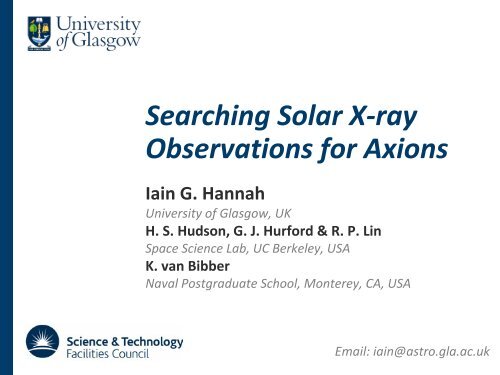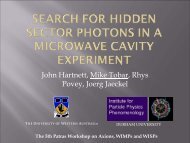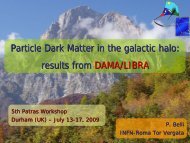Searching Solar X-ray Observations for Axions
Searching Solar X-ray Observations for Axions
Searching Solar X-ray Observations for Axions
Create successful ePaper yourself
Turn your PDF publications into a flip-book with our unique Google optimized e-Paper software.
<strong>Searching</strong> <strong>Solar</strong> X‐<strong>ray</strong><br />
<strong>Observations</strong> <strong>for</strong> <strong>Axions</strong><br />
Iain G. Hannah<br />
University of Glasgow, UK<br />
H. S. Hudson, G. J. Hur<strong>for</strong>d & R. P. Lin<br />
Space Science Lab, UC Berkeley, USA<br />
K. van Bibber<br />
Naval Postgraduate School, Monterey, CA, USA<br />
Email: iain@astro.gla.ac.uk
Hannah–Durham, July 2009<br />
Motivation & Outline<br />
Can we observe the X‐<strong>ray</strong> signal from axions<br />
converting directly in the solar atmosphere?<br />
•Summary of basic ideas & properties of expected axions signal<br />
•Some solar physics<br />
– Density & magnetic fields of the solar atmosphere<br />
– Competing <strong>Solar</strong> X‐<strong>ray</strong> emission<br />
•Current <strong>Solar</strong> <strong>Observations</strong><br />
– Hard X‐<strong>ray</strong> (HXR) with RHESSI<br />
– Soft X‐<strong>ray</strong> (SXR) with Yohkoh/SXT and Hinode/XRT<br />
•Future <strong>Observations</strong><br />
– NuSTAR, NEXT, FOXSI........<br />
•Conclusions<br />
2
• Predicted axion spectrum from core will feature<br />
Hannah–Durham, July 2009<br />
<strong>Axions</strong> from <strong>Solar</strong> Core<br />
– Continuum emission (Sikivie 1983, van Bibber et al 1989)<br />
– 57 Fe spectral line at 14.4 keV (Moriyama 1995)<br />
Moriyama 1995<br />
Data from Raffelt<br />
– Although likely to be faint, unique spectral and spatial distribution<br />
3
Hannah–Durham, July 2009<br />
Geometry <strong>for</strong> Coronal Conversion<br />
• Conversion of axion to X‐<strong>ray</strong> in coronal magnetic field (Carlson & Tseng<br />
1996)<br />
• Detect X‐<strong>ray</strong>s from appropriate spacecraft<br />
<strong>Axions</strong><br />
• Or conversion in Earth’s night side magnetic field (Davoudiasl & Huber 2006)<br />
– No competing <strong>Solar</strong> X‐<strong>ray</strong>s<br />
B<br />
X‐<strong>ray</strong>s<br />
*not to scale<br />
4
– Carlson & Tseng 1996<br />
Hannah–Durham, July 2009<br />
Probability of Axion Conversion<br />
• This depends on the density and perpendicular magnetic field structure in<br />
the solar atmosphere the axion encounters<br />
• So to estimate the detectability of X‐<strong>ray</strong>s from solar axions<br />
– Need to know n,B as a function of (x,y,z) in the solar atmosphere<br />
– Then need to compare this to the other competing sources of X‐<strong>ray</strong><br />
emission from the Sun.<br />
5
• Simple Dipole Field<br />
– B perp ~ 10 ‐3 T at photosphere<br />
Hannah–Durham, July 2009<br />
"Simple" B & Density Model<br />
<strong>Solar</strong> Wind<br />
Corona<br />
Chromosphere<br />
Photosphere<br />
• Gary 2001<br />
• n, T and B vary with height<br />
6
• Do not accurately know B<br />
Hannah–Durham, July 2009<br />
Problems Determining Magnetic Field<br />
– Can measure the photospheric line‐of‐sight B from Zeeman splitting<br />
– Estimate coronal field by extrapolation (�xB = αB)<br />
• Schrijver‐DeRosa PFSS method (takes α=0)<br />
– But this is a current free extrapolation<br />
• So no magnetic energy available <strong>for</strong> the magnetic phenomena we observe<br />
– So this model is a start but nowhere near the complete picture<br />
7
Hannah–Durham, July 2009<br />
Further Issues<br />
• Even if using more accurate extrapolation depends on resolution of<br />
magnetograms<br />
– With higher spatial resolution instruments (like Hinode/SOT) observing<br />
"ubiquitous presence of horizontal magnetic field" in very quiet Sun<br />
regions ‐ Lites et al 2008<br />
– This is an active field of research since all phenomena we observe in the<br />
Sun's atmosphere are magnetic<br />
• If we had quantitative knowledge of the magnetic field we could determine<br />
which of our models/theories are correct<br />
• <strong>Solar</strong> atmosphere is highly dynamic on a variety of timescales<br />
– From seconds to 11‐year activity cycle to even longer!<br />
• So difficult to convolve Axion flux with realistic n,B to get Axion X‐<strong>ray</strong><br />
spectrum<br />
8
• The solar 2 product is much larger<br />
than that achievable in laboratories<br />
– But the field is strongly variable in<br />
both space and time, and not well<br />
known quantitatively<br />
• Magnetic fields drive solar<br />
activity/phenomena,<br />
– potentially confused with the axion<br />
signal or a source of background<br />
• "Figure of Merit" calculation<br />
– ε= efficiency, A= detector area, Δt=<br />
integration time, B = background rate, ΔE=<br />
energy range<br />
Hannah–Durham, July 2009<br />
Merit of Space Observation<br />
>4 orders of<br />
magnitude bigger<br />
PFSS Magnetic Fields (Hudson)<br />
Detector FOM<br />
CAST 1.0<br />
RHESSI 0.005<br />
57 Fe* 2x10 3<br />
X‐<strong>ray</strong>** 7x10 4<br />
Both assume SMEX level spacecraft<br />
*14.4 kev photonuclear γ‐<strong>ray</strong><br />
**1000 cm 2 , B = 2x10 ‐4 (cm 2 .sec.keV) ‐1<br />
9
Hannah–Durham, July 2009<br />
Soft X‐<strong>ray</strong> <strong>Solar</strong> Images<br />
• Yohkoh SXT images from maximum of solar cycle (1991) to minimum<br />
(1995)<br />
<strong>Solar</strong> Max : Flares,<br />
Active Regions &<br />
Hot Loops<br />
<strong>Solar</strong> Min: X‐<strong>ray</strong><br />
Bright Points in<br />
the Quiet Sun<br />
10
• From December 2006, approaching solar minimum<br />
Hannah–Durham, July 2009<br />
Hinode/XRT <strong>Solar</strong> Image<br />
Copious features and activity<br />
even in the quiet Sun!<br />
11
• Observe flares (large to<br />
micro) in SXR and HXR<br />
– SXR: thermal brems<br />
continuum and spectral<br />
lines<br />
– HXR: non‐thermal e ‐<br />
brems continuum<br />
• <strong>Solar</strong> Max: Active Regions<br />
during solar max easily<br />
observed in SXR, HXR difficult<br />
• <strong>Solar</strong> Min: Quiet Sun/X‐<strong>ray</strong><br />
Bright Points easily observed<br />
in SXR, HXR difficult<br />
– See RHESSI Quiet Sun work<br />
Hannah–Durham, July 2009<br />
<strong>Solar</strong> X‐<strong>ray</strong> Spectra<br />
• Un<strong>for</strong>tunately <strong>for</strong> axions the Sun is bright in X‐<strong>ray</strong>s from a variety of<br />
magnetic phenomena<br />
Modified from Churazov et al. 2008 MNRAS<br />
12
Hannah–Durham, July 2009<br />
Multi‐wavelength Approach<br />
• Our knowledge of the processes involved in the solar atmosphere is due to<br />
observations at multiple wavelengths/detecting particles in‐situ<br />
8‐Feb‐2001<br />
– Observational solar physics is a multi‐messenger displine<br />
Radio<br />
Electrons<br />
• The problems of solar atmospheric physics is trying to understand this vast ar<strong>ray</strong> of<br />
highly complex & dynamic multi‐wavelength observations of magnetic phenomena<br />
when we do not quantitatively know what the magnetic field is doing.<br />
21‐Nov‐2006<br />
13
Hannah–Durham, July 2009<br />
RHESSI Quiet Sun Upper Limits<br />
• Reuven Ramaty High Energy <strong>Solar</strong> Spectroscopic Imager<br />
– NASA, operating since 2002<br />
• High spatial, temporal, energy resolution over 3keV to 17 MeV<br />
• Designed <strong>for</strong> bright compact flare observations<br />
– Not <strong>for</strong> large faint sources like Quiet Sun<br />
• Offpointing need to chop<br />
"signal"<br />
• Data up to April 2009<br />
• Still just upper limits<br />
• Even if actual signal it would<br />
NOT be dominated by axions<br />
• Thermal emission from hot<br />
XBPs seen in SXR<br />
• Non‐thermal emission from<br />
accelerated electrons in HXR<br />
quiet Sun/nanoflares<br />
14
Hannah–Durham, July 2009<br />
Yohkoh Soft X‐<strong>ray</strong> Telescope (SXT)<br />
• Japanese with UK & NASA, operational 1991 to 2001<br />
• SXT: SXR focusing optics telescope with variety of filters<br />
– 0.25 to 4 keV 1024x1024 CCD detector<br />
• Stack images from during <strong>Solar</strong> minimum (1996)<br />
• Choose those with no Active Regions near disc centre<br />
• No evidence of axions<br />
• Bands of Active Regions and<br />
features moving across the<br />
disc as the Sun rotates (left<br />
to right)<br />
• Hudson & Acton plan further<br />
work<br />
15
• Japanese with UK & NASA, launched 2006<br />
Hannah–Durham, July 2009<br />
Hinode X‐<strong>ray</strong> Telescope (XRT)<br />
• XRT: SXR focusing optics telescope with variety of filters<br />
– 0.03keV to 2keV with 2048x2048 CCD<br />
• Observing campaign took many images with<br />
– long exposure (11.5s) through thick filter (Be‐Med)<br />
Histogram Analysis/Not "image"<br />
• Histogram Analysis<br />
• Each pixel shows high energy<br />
tail of histogram of that pixel<br />
from all energies<br />
• No evidence of <strong>Axions</strong><br />
• Further work needed<br />
16
Hannah–Durham, July 2009<br />
Future <strong>Solar</strong> Focusing HXR Telescopes<br />
• Need hard X‐<strong>ray</strong> focusing optics solar X‐<strong>ray</strong> telescope<br />
– Ideally imaging spectrometer from a few to
Hannah–Durham, July 2009<br />
Future Focusing HXR Telescope<br />
• Astrophysical HXR focusing optic telescopes that are being developed<br />
– NASA's NuSTAR – Launch 2011<br />
• Wolter‐I optics on deployable mast, 6 ‐ 79 keV CZT detectors<br />
• Opportunity <strong>for</strong> sun pointing (hopefully)<br />
• http://www.nustar.caltech.edu/home<br />
– JAXA's Astro‐H or NeXT – Launch 2013<br />
• 5‐80 keV, Si/CST detectors (& other instruments)<br />
• Sun pointing unlikely<br />
• http://astro‐h.isas.jaxa.jp/<br />
18
Hannah–Durham, July 2009<br />
Conclusions<br />
• Conversion in the solar magnetic field should be the best way<br />
to see solar thermal axions of low mass<br />
• As the density and magnetic field structure of the solar<br />
atmosphere is not well understood an axion signal would be<br />
difficult to interpret<br />
• Calculations of resonance conditions in realistic solar (B, n)<br />
distribution need to be done<br />
• Future instrumentation could greatly improve sensitivity<br />
– Although still difficult to separate X‐<strong>ray</strong>s from axions and the<br />
copious conventional X‐<strong>ray</strong> emission<br />
19




